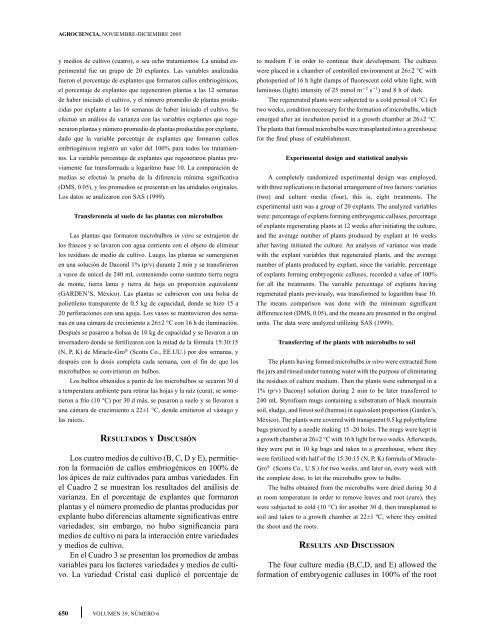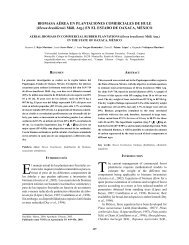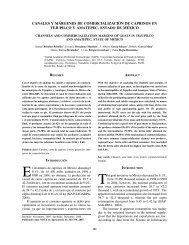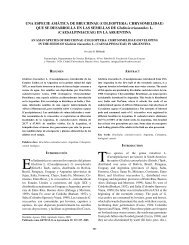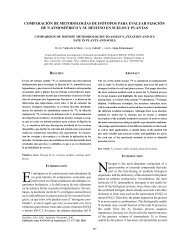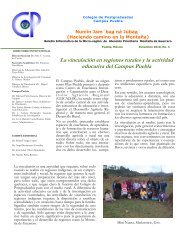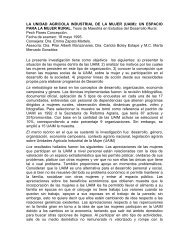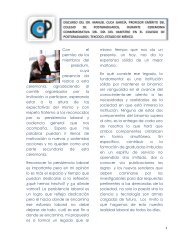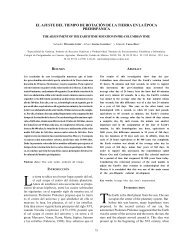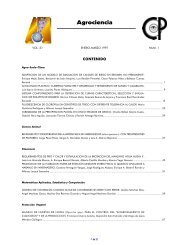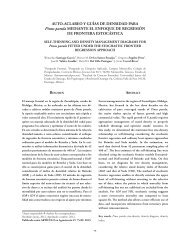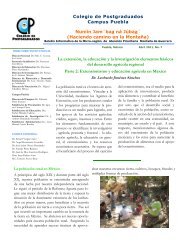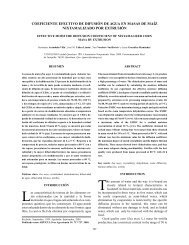04-161 (Regeneración in vitro) - Colegio de Postgraduados
04-161 (Regeneración in vitro) - Colegio de Postgraduados
04-161 (Regeneración in vitro) - Colegio de Postgraduados
Create successful ePaper yourself
Turn your PDF publications into a flip-book with our unique Google optimized e-Paper software.
AGROCIENCIA, NOVIEMBRE-DICIEMBRE 2005<br />
y medios <strong>de</strong> cultivo (cuatro), o sea ocho tratamientos. La unidad experimental<br />
fue un grupo <strong>de</strong> 20 explantes. Las variables analizadas<br />
fueron el porcentaje <strong>de</strong> explantes que formaron callos embriogénicos,<br />
el porcentaje <strong>de</strong> explantes que regeneraron plantas a las 12 semanas<br />
<strong>de</strong> haber <strong>in</strong>iciado el cultivo, y el número promedio <strong>de</strong> plantas producidas<br />
por explante a las 16 semanas <strong>de</strong> haber <strong>in</strong>iciado el cultivo. Se<br />
efectuó un análisis <strong>de</strong> varianza con las variables explantes que regeneraron<br />
plantas y número promedio <strong>de</strong> plantas producidas por explante,<br />
dado que la variable porcentaje <strong>de</strong> explantes que formaron callos<br />
embriogénicos registró un valor <strong>de</strong>l 100% para todos los tratamientos.<br />
La variable porcentaje <strong>de</strong> explantes que regeneraron plantas previamente<br />
fue transformada a logaritmo base 10. La comparación <strong>de</strong><br />
medias se efectuó la prueba <strong>de</strong> la diferencia mínima significativa<br />
(DMS, 0.05), y los promedios se presentan en las unida<strong>de</strong>s orig<strong>in</strong>ales.<br />
Los datos se analizaron con SAS (1999).<br />
Transferencia al suelo <strong>de</strong> las plantas con microbulbos<br />
Las plantas que formaron microbulbos <strong>in</strong> <strong>vitro</strong> se extrajeron <strong>de</strong><br />
los frascos y se lavaron con agua corriente con el objeto <strong>de</strong> elim<strong>in</strong>ar<br />
los residuos <strong>de</strong> medio <strong>de</strong> cultivo. Luego, las plantas se sumergieron<br />
en una solución <strong>de</strong> Daconil 1% (p/v) durante 2 m<strong>in</strong> y se transfirieron<br />
a vasos <strong>de</strong> unicel <strong>de</strong> 240 mL conteniendo como sustrato tierra negra<br />
<strong>de</strong> monte, tierra lama y tierra <strong>de</strong> hoja en proporción equivalente<br />
(GARDEN’S, México). Las plantas se cubrieron con una bolsa <strong>de</strong><br />
polietileno transparente <strong>de</strong> 0.5 kg <strong>de</strong> capacidad, don<strong>de</strong> se hizo 15 a<br />
20 perforaciones con una aguja. Los vasos se mantuvieron dos semanas<br />
en una cámara <strong>de</strong> crecimiento a 26±2 °C con 16 h <strong>de</strong> ilum<strong>in</strong>ación.<br />
Después se pasaron a bolsas <strong>de</strong> 10 kg <strong>de</strong> capacidad y se llevaron a un<br />
<strong>in</strong>verna<strong>de</strong>ro don<strong>de</strong> se fertilizaron con la mitad <strong>de</strong> la fórmula 15:30:15<br />
(N, P, K) <strong>de</strong> Miracle-Gro ® (Scotts Co., EE.UU.) por dos semanas, y<br />
<strong>de</strong>spués con la dosis completa cada semana, con el f<strong>in</strong> <strong>de</strong> que los<br />
microbulbos se convirtieran en bulbos.<br />
Los bulbos obtenidos a partir <strong>de</strong> los microbulbos se secaron 30 d<br />
a temperatura ambiente para retirar las hojas y la raíz (cura), se sometieron<br />
a frío (10 °C) por 30 d más, se pasaron a suelo y se llevaron a<br />
una cámara <strong>de</strong> crecimiento a 22±1 °C, don<strong>de</strong> emitieron el vástago y<br />
las raíces.<br />
RESULTADOS Y DISCUSIÓN<br />
Los cuatro medios <strong>de</strong> cultivo (B, C, D y E), permitieron<br />
la formación <strong>de</strong> callos embriogénicos en 100% <strong>de</strong><br />
los ápices <strong>de</strong> raíz cultivados para ambas varieda<strong>de</strong>s. En<br />
el Cuadro 2 se muestran los resultados <strong>de</strong>l análisis <strong>de</strong><br />
varianza. En el porcentaje <strong>de</strong> explantes que formaron<br />
plantas y el número promedio <strong>de</strong> plantas producidas por<br />
explante hubo diferencias altamente significativas entre<br />
varieda<strong>de</strong>s; s<strong>in</strong> embargo, no hubo significancia para<br />
medios <strong>de</strong> cultivo ni para la <strong>in</strong>teracción entre varieda<strong>de</strong>s<br />
y medios <strong>de</strong> cultivo.<br />
En el Cuadro 3 se presentan los promedios <strong>de</strong> ambas<br />
variables para los factores varieda<strong>de</strong>s y medios <strong>de</strong> cultivo.<br />
La variedad Cristal casi duplicó el porcentaje <strong>de</strong><br />
650 VOLUMEN 39, NÚMERO 6<br />
to medium F <strong>in</strong> or<strong>de</strong>r to cont<strong>in</strong>ue their <strong>de</strong>velopment. The cultures<br />
were placed <strong>in</strong> a chamber of controlled environment at 26±2 °C with<br />
photoperiod of 16 h light (lamps of fluorescent cold white light, with<br />
lum<strong>in</strong>ous (light) <strong>in</strong>tensity of 25 mmol m −2 s −1 ) and 8 h of dark.<br />
The regenerated plants were subjected to a cold period (4 °C) for<br />
two weeks, condition necessary for the formation of microbulbs, which<br />
emerged after an <strong>in</strong>cubation period <strong>in</strong> a growth chamber at 26±2 °C.<br />
The plants that formed microbulbs were transplanted <strong>in</strong>to a greenhouse<br />
for the f<strong>in</strong>al phase of establishment.<br />
Experimental <strong>de</strong>sign and statistical analysis<br />
A completely randomized experimental <strong>de</strong>sign was employed,<br />
with three replications <strong>in</strong> factorial arrangement of two factors: varieties<br />
(two) and culture media (four), this is, eight treatments. The<br />
experimental unit was a group of 20 explants. The analyzed variables<br />
were: percentage of explants form<strong>in</strong>g embryogenic calluses, percentage<br />
of explants regenerat<strong>in</strong>g plants at 12 weeks after <strong>in</strong>itiat<strong>in</strong>g the culture,<br />
and the average number of plants produced by explant at 16 weeks<br />
after hav<strong>in</strong>g <strong>in</strong>itiated the culture. An analysis of variance was ma<strong>de</strong><br />
with the explant variables that regenerated plants, and the average<br />
number of plants produced by explant, s<strong>in</strong>ce the variable, percentage<br />
of explants form<strong>in</strong>g embryogenic calluses, recor<strong>de</strong>d a value of 100%<br />
for all the treatments. The variable percentage of explants hav<strong>in</strong>g<br />
regenerated plants previously, was transformed to logarithm base 10.<br />
The means comparison was done with the m<strong>in</strong>imum significant<br />
difference test (DMS, 0.05), and the means are presented <strong>in</strong> the orig<strong>in</strong>al<br />
units. The data were analyzed utiliz<strong>in</strong>g SAS (1999).<br />
Transferr<strong>in</strong>g of the plants with microbulbs to soil<br />
The plants hav<strong>in</strong>g formed microbulbs <strong>in</strong> <strong>vitro</strong> were extracted from<br />
the jars and r<strong>in</strong>sed un<strong>de</strong>r runn<strong>in</strong>g water with the purpose of elim<strong>in</strong>at<strong>in</strong>g<br />
the residues of culture medium. Then the plants were submerged <strong>in</strong> a<br />
1% (p/v) Daconyl solution dur<strong>in</strong>g 2 m<strong>in</strong> to be later transferred to<br />
240 mL Styrofoam mugs conta<strong>in</strong><strong>in</strong>g a substratum of black mounta<strong>in</strong><br />
soil, sludge, and forest soil (humus) <strong>in</strong> equivalent proportion (Gar<strong>de</strong>n’s,<br />
México). The plants were covered with transparent 0.5 kg polyethylene<br />
bags pierced by a needle mak<strong>in</strong>g 15 -20 holes. The mugs were kept <strong>in</strong><br />
a growth chamber at 26±2 °C with 16 h light for two weeks. Afterwards,<br />
they were put <strong>in</strong> 10 kg bags and taken to a greenhouse, where they<br />
were fertilized with half of the 15:30:15 (N, P, K) formula of Miracle-<br />
Gro ® (Scotts Co., U.S.) for two weeks, and later on, every week with<br />
the complete dose, to let the microbulbs grow to bulbs.<br />
The bulbs obta<strong>in</strong>ed from the microbulbs were dried dur<strong>in</strong>g 30 d<br />
at room temperature <strong>in</strong> or<strong>de</strong>r to remove leaves and root (cure), they<br />
were subjected to cold (10 °C) for another 30 d, then transplanted to<br />
soil and taken to a growth chamber at 22±1 ºC, where they emitted<br />
the shoot and the roots.<br />
RESULTS AND DISCUSSION<br />
The four culture media (B,C,D, and E) allowed the<br />
formation of embryogenic calluses <strong>in</strong> 100% of the root


